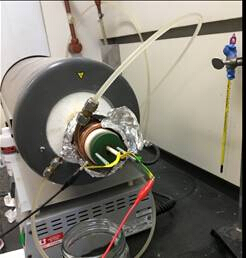電気化学インピーダンス分光法
概要
出典:カラ・イングラハム、ジャレッド・マカッチェン、テイラー・D・スパークス、ユタ大学材料工学科、ソルトレーク・シティー、UT
電気抵抗は、電気の流れに抵抗する電気回路素子の能力です。抵抗はオームの法則によって定義されます。
 (式1)
(式1)
電圧 はどこにいて、
はどこにいて、 電流です。オームの法則は、理想的な抵抗の抵抗を決定するのに役立ちます。しかし、多くの回路素子はより複雑であり、抵抗だけでは説明できません。たとえば、交流電流(AC)を使用する場合、抵抗率はAC信号の周波数に依存することがよくあります。電気インピーダンスは、抵抗を単独で使用するのではなく、電気の流れに抵抗する回路素子の能力のより正確で一般化可能な尺度です。
電流です。オームの法則は、理想的な抵抗の抵抗を決定するのに役立ちます。しかし、多くの回路素子はより複雑であり、抵抗だけでは説明できません。たとえば、交流電流(AC)を使用する場合、抵抗率はAC信号の周波数に依存することがよくあります。電気インピーダンスは、抵抗を単独で使用するのではなく、電気の流れに抵抗する回路素子の能力のより正確で一般化可能な尺度です。
最も一般的には、電気インピーダンス測定の目標は、抵抗、静電容量、誘導などのさまざまなメカニズムからの寄与に対するサンプルの総電気インピーダンスのデコンボリューションです。
手順
- テストモジュールを入手し、2つの電極を介してEIS機器に接続します。図 3に示すテスト モジュールは、単純な既知の回路のモデル化に使用できるデータを提供します。これは、ワイヤが機械に正しく接続されていること、およびすべての機械部品が機能していることを確認するために使用できます。

図3: テストモジュール
- サンプルを流し始めるには、コンピュータでZplotソフトウェアを開きます。このソフトウェアから、必要に応じてサンプルのパラメータを設定できます。テストモジュールでテストを実行する場合は、「偏光」でDCポテンシャルを0に設定し、AC振幅を10 mVに設定し、ドロップダウン矢印に「対オープン回路」と表示されていることを確認します。「周波数スイープ」セクションで、初期周波数を1x
結果
申請書と概要
タグ
スキップ先...
このコレクションのビデオ:

Now Playing
電気化学インピーダンス分光法
Materials Engineering
23.2K 閲覧数

光学材料グラフィー パート 1: サンプル調製
Materials Engineering
15.4K 閲覧数

光学材料学 パート2:画像解析
Materials Engineering
11.0K 閲覧数

X線光電子分光法
Materials Engineering
21.6K 閲覧数

X線回折
Materials Engineering
89.0K 閲覧数

集束イオンビーム
Materials Engineering
8.9K 閲覧数

方向固化と位相安定化
Materials Engineering
6.5K 閲覧数

微分走査熱量測定
Materials Engineering
37.5K 閲覧数

熱拡散率とレーザーフラッシュ法
Materials Engineering
13.2K 閲覧数

薄膜の電気めっき
Materials Engineering
20.1K 閲覧数

拡張測定による熱膨張の解析
Materials Engineering
15.7K 閲覧数

セラミックマトリックス複合材料とその曲げ特性
Materials Engineering
8.1K 閲覧数

ナノ結晶合金とナノ粒サイズ安定性
Materials Engineering
5.1K 閲覧数

ヒドロゲル合成
Materials Engineering
23.7K 閲覧数
Copyright © 2023 MyJoVE Corporation. All rights reserved


